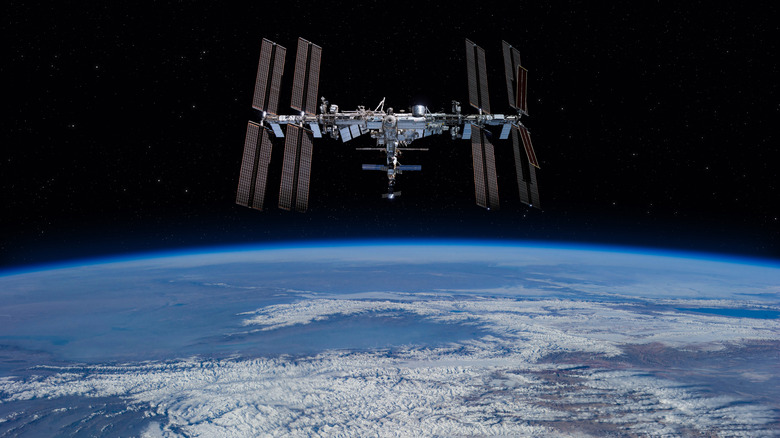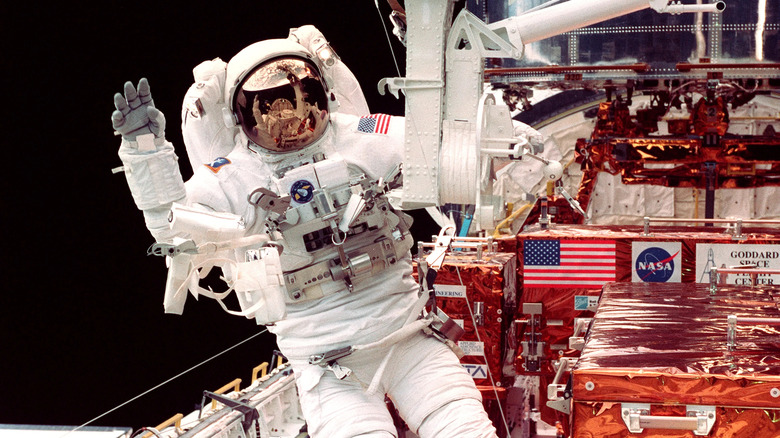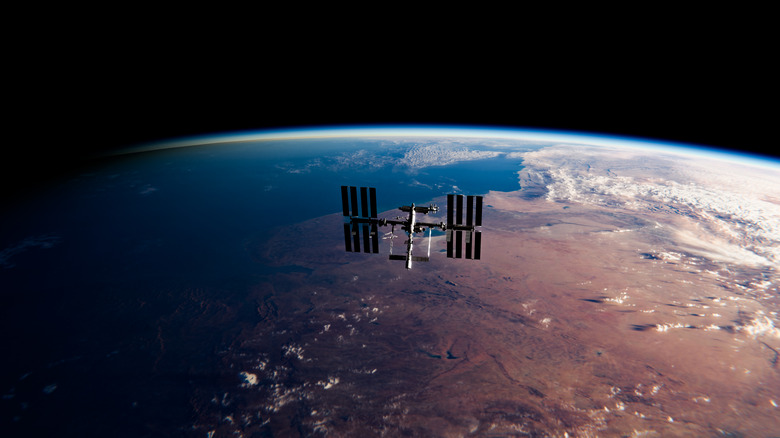Here's How Astronauts On The ISS Repair Broken Space Telescopes
Like any piece of technology, large science telescopes sometimes break down. Whether it's a problem with an onboard computer or a piece of hardware, telescopes are highly technical machines that often need some maintenance. That can be challenging enough with large telescopes on Earth, but it's much, much harder when the telescope is in space.
Engineers do everything they can to avoid needing to make fixes to space telescopes. Spacecraft are typically designed with multiple layers of redundancy so that even if one part does break, there's another that can cover it. Designs try to anticipate the difficult environments that a spacecraft will face during launch and while in space, and spacecraft are rigorously tested before launch to make sure that the hardware can handle it. Still, even with all this planning, sometimes problems occur. In May 2023, for example, NASA scientists discovered a problem with the NICER (Neutron Star Interior Composition Explorer) telescope. It had a light leak that allowed sunlight in and affected the telescope's X-ray readings.
"The sunlight interferes with NICER's ability to collect viable X-ray measurements during the station's daytime," NICER science lead Zaven Arzoumanian said in a NASA statement in April 2024. "Nighttime observations are unaffected, and the telescope continues to produce incredible science." Still, to get the most out of the telescope, NASA needed to conduct proper repairs.
Repairs in space are never simple
Some space telescopes are difficult or almost impossible to repair. The James Webb Space Telescope, for example, doesn't orbit Earth — it actually orbits the sun, in a complex orbit called L2. If Webb ever needed repairs, it would be extremely difficult for anyone to reach it.
One of the most famous telescope repair missions was for the Hubble Space Telescope. Hubble orbits the Earth in low orbit, so it's relatively easy to get to, but it still required a special series of space shuttle missions to fix. A series of Hubble servicing missions were performed between 1993 and 2009, with the most important occurring in December 1993 to fix a flaw in Hubble's primary mirror that was causing its pictures to look blurry. These missions were technically challenging and costly, though fortunately, they succeeded in fixing the issue with Hubble and adding upgrades like new instruments to it over the years.
With NICER, repairs are a bit easier because the instrument is located on the outside of the International Space Station (ISS). That means that astronauts don't have to travel on a special trip to fix it as there's already a crew stationed there. However, maintenance can still be difficult, as the device wasn't intended to be serviced by astronauts.
"We didn't design NICER for mission servicing," NICER's principal investigator at Goddard Space Flight Center Keith Gendreau said in a NASA statement in April 2024. "The possibility of a repair has been an exciting challenge. We considered both spacewalk and robotic solutions, puzzling out how to install patches using what's already present on the telescope and in space station toolkits."
NASA has a plan to fix NICER
In the end, the NICER team decided that they needed astronauts living on the International Space Station to perform a spacewalk to fix the instrument. This will make NICER one of the rare science observatories to have been repaired by astronauts while in orbit, joining the Hubble Space Telescope, the Solar Maximum Mission, and the Alpha Magnetic Spectrometer.
The problem with NICER's light leak stems from damage to its sunshade, a piece of carbon composite designed to block out the sunlight. Fortunately, the hardware for fixing NICER's light leak issue is relatively simple, consisting of five wedges that will be slotted into the sunshade to cover the damaged areas. But even with a solid solution, working on delicate equipment in zero gravity while wearing a cumbersome spacesuit is never easy.
"While we worked hard to ensure the patches are mechanically simple, most repair activities in space are very complicated," said Steve Kenyon, NICER's mechanical lead at NASA's Goddard Space Flight Center, in a statement. "We've been conducting tests to confirm the repair work will be both an effective fix for NICER's light leak and completely safe for the astronauts on the spacewalk and the space station."
The exact date for the spacewalk hasn't been announced yet, nor has NASA specified which astronauts will be performing the work. The agency has announced, though, that the patches for the repair will be sent to the ISS on a cargo resupply mission to the station called Cygnus NG-21, scheduled for August 2024, and that the spacewalk for the repairs should be performed sometime later this year.


